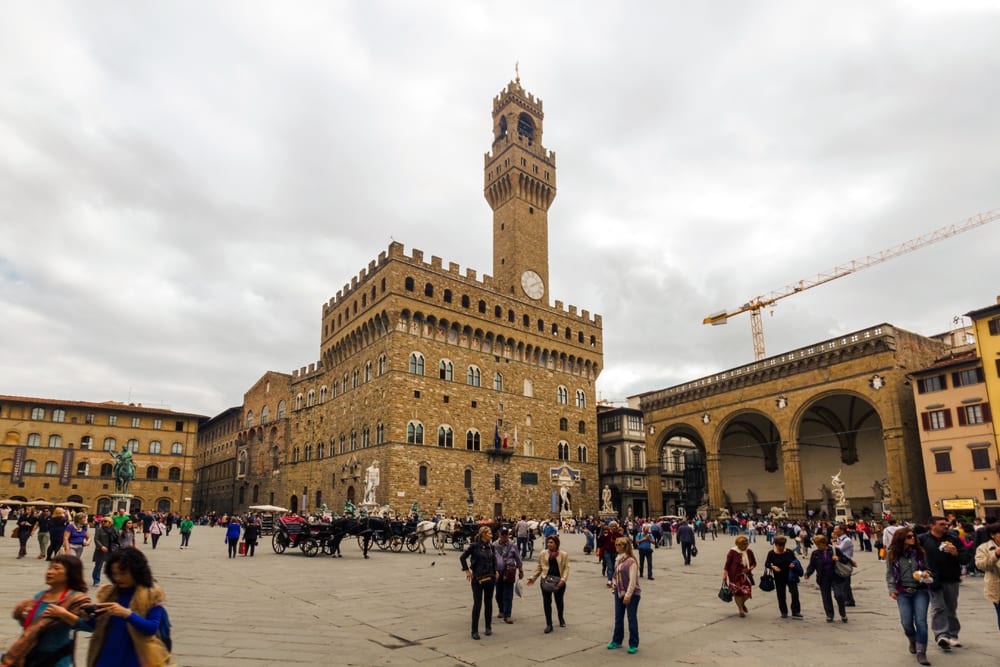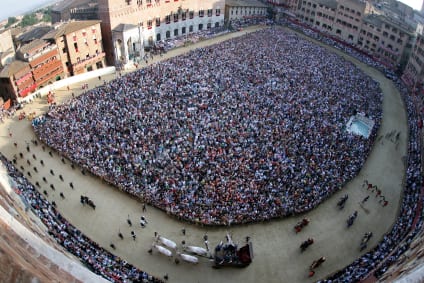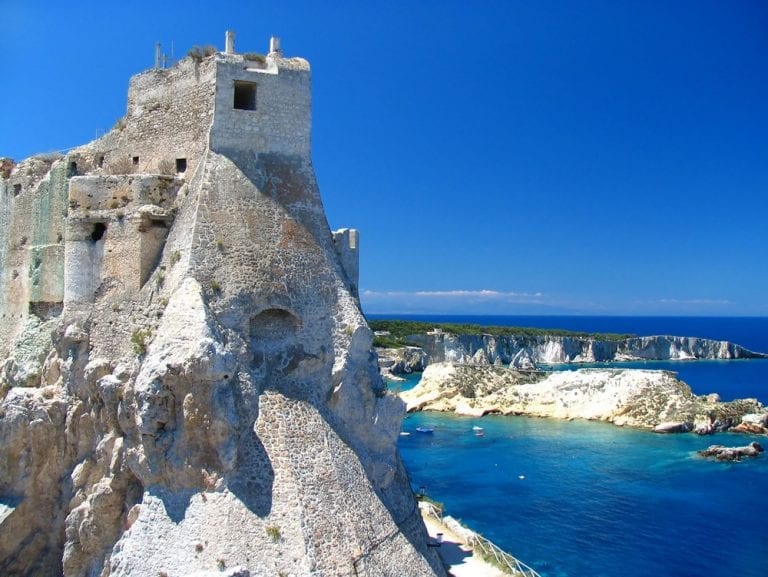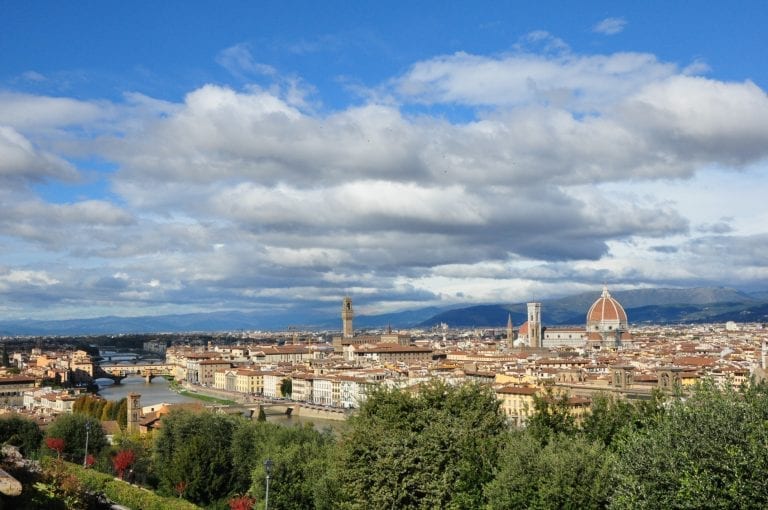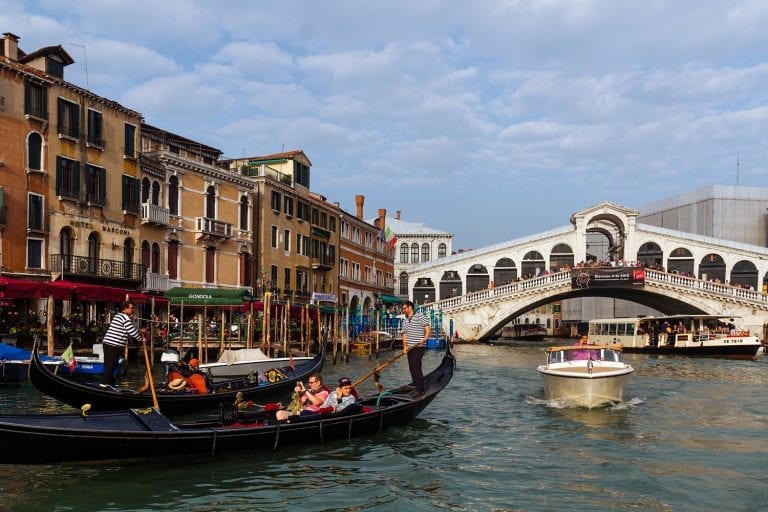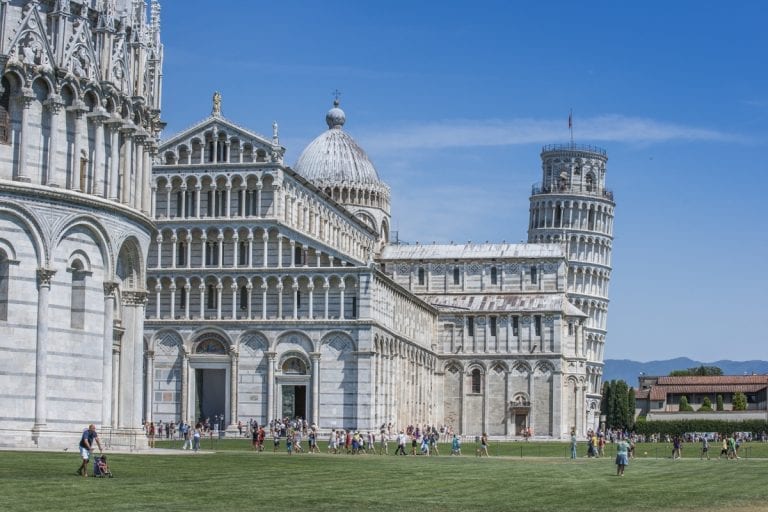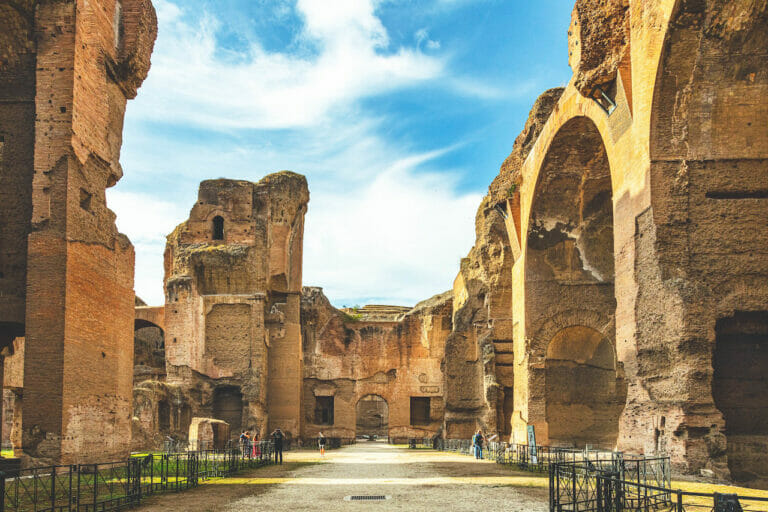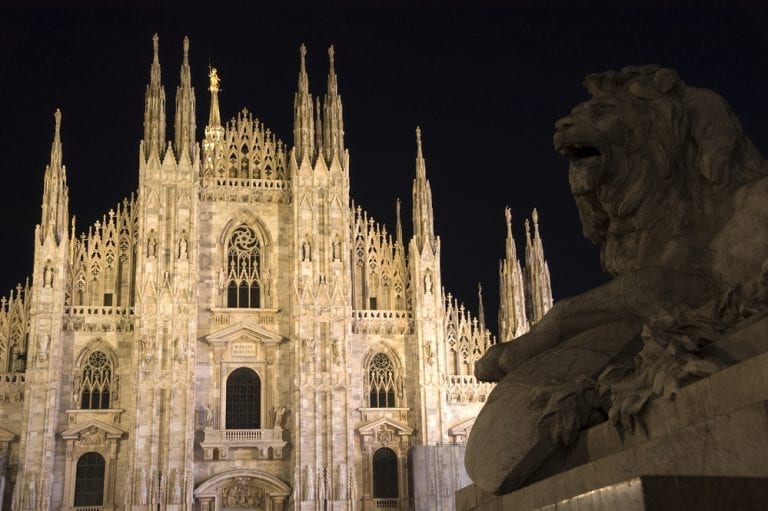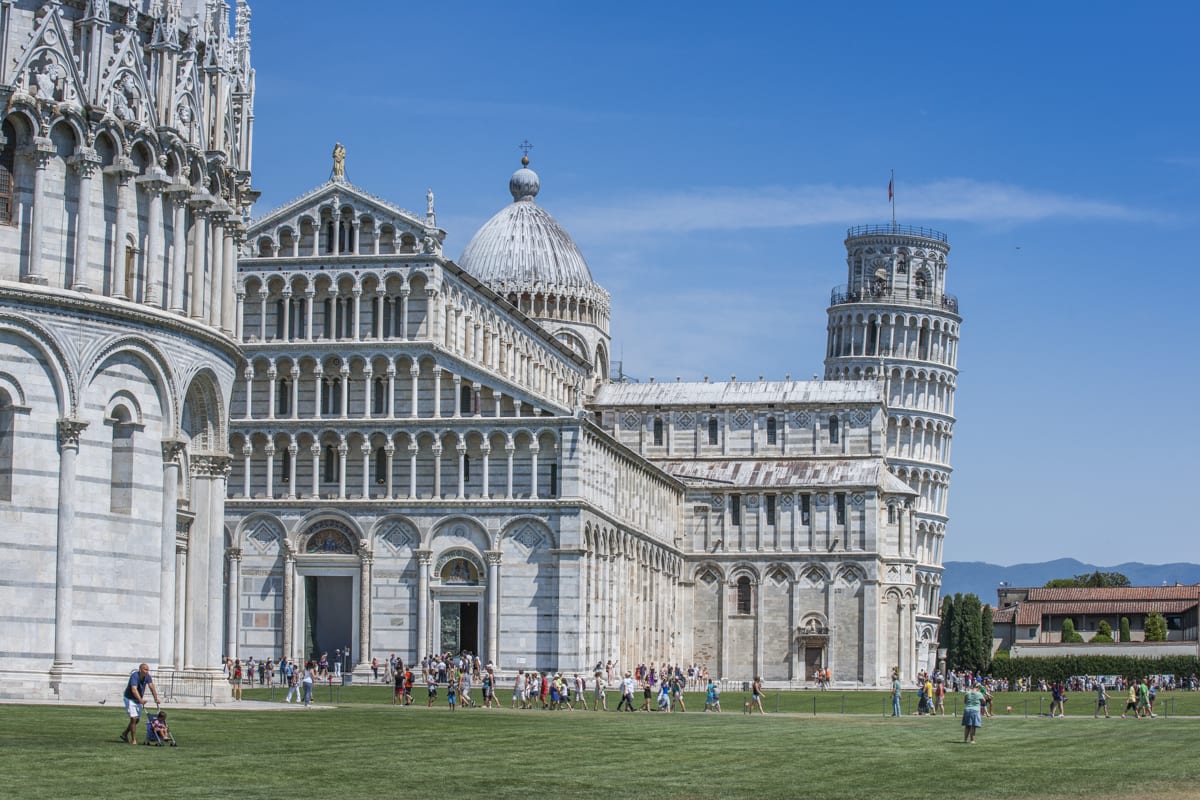
The 14 Italian Piazzas that Every Traveler Should See
November 13, 2024
Italian piazzas, or squares, are the beating hearts of every Italian town and city. They can be big or small, intimate or dramatic, humble, opulent, old, new and everything in between. In fact, sometimes a piazza isn’t a square at all (see: the Piazza del Campo in Siena, among others).
What all Italian piazzas have in common is their civic and symbolic importance. They’re the physical center of the community and also its prime outdoor theater; home to the most important political buildings, the main cathedral, cafes, restaurants, and sometimes monuments or fountains. There’s no better place to people watch in Italy than in a piazza. We’ve compiled a list of our 14 favorite Italian piazzas but before we get to it, a brief note on history…
Table of Contents
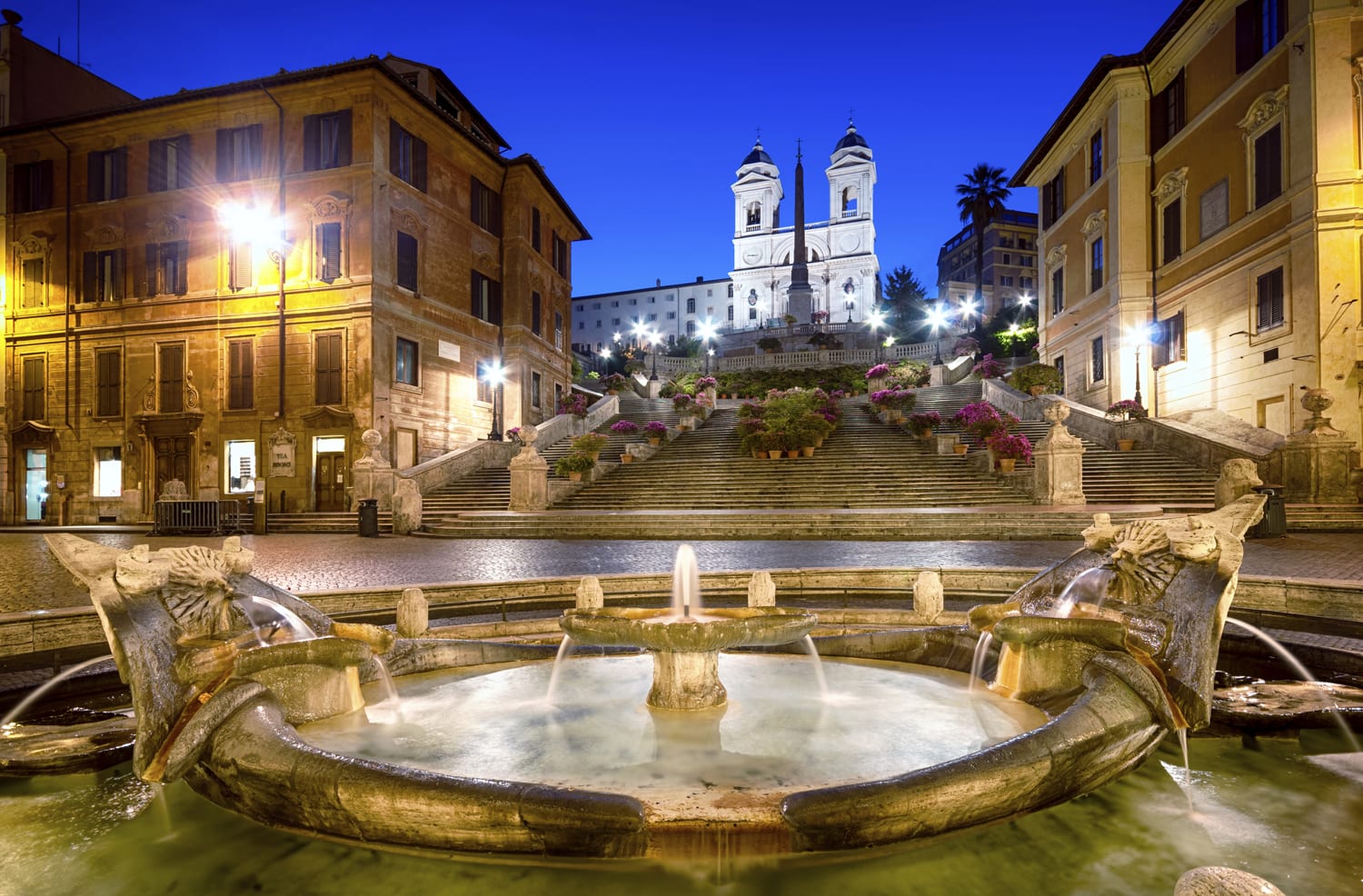
Ancient Origins of the Italian Piazza
It’s said that Italian piazzas were first formed by the ancient Roman practice of building roads in a grid system. The point at which the two main roads intersected was prime real estate and almost always contained a temple, which would be the focal point of what later became a piazza. Temples were replaced by churches throughout the 4th and 5th centuries as Christianity spread and government buildings, markets, shops and apartments filled in around the sides. As the power of Imperial Rome declined toward the ladder part of the 5th centuries the towns fortified themselves to defend from attacks, and the piazza became a safe nucleus inside a fortified city. During the Renaissance, piazzas in Italy were celebrated, and in the 17th century heavily adorned with Baroque embellishments.
Throughout history, Italian piazzas have witnessed innumerable hangings, duels, and battles. They have also hosted just as many weddings, baptisms, festivals, fireworks, and markets. Today the Italian piazza is as celebrated as ever and just as much a center of daily life in Italy. Here are some of our favorite famous, and lesser known, Italian piazzas.
Can’t-Miss Italian Piazzas
Piazza dell’Unità d’Italia, Trieste
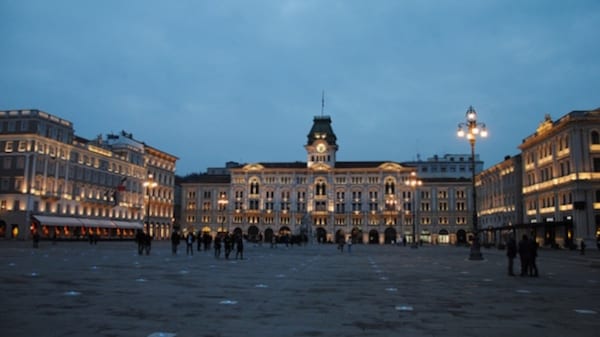
Magnificent buildings frame three sides of the Piazza Grande and on the fourth side is the sea. | Photo by Leandro Neumann Ciuffo
Also known as simply Piazza dell’Unità or Piazza Grande, this is one big square! The piazza sits in the center of Trieste and has one of the most unique locations in the country. Its classic rectangular shape opens up directly to the sea, paying homage to Trieste’s shipping history and making it the only sea-facing Italian piazza.
The piazza also contains many of Trieste’s most picturesque attractions, like the Palazzo Comunale, the Four Continents Fountain, and other important political buildings. Trieste’s location on Italy’s northeastern border gives the piazza a decidedly Austrian flare with architecture that comes directly from the city’s time under Austro-Hungarian rule during the 19th century.
Piazza San Marco, Venice
The Venetian Republic gained power at the end of the Middle Ages and the impressive Piazza San Marco grew right along with it, eventually becoming one of the most famous squares in the entire world. Famously called the “drawing room of Europe,” it’s dominated by the Byzantine architecture of St Mark’s Basilica and its titanic bell tower. The square is special for its unique atmosphere and environment – right on the Venetian lagoon!
The only genuine piazza in Venice (the other squares have a different title), Piazza San Marco draws thousands of visitors daily, tourists and residents alike. If you like a stiff drink stop off for a negroni, or even better, a bellini (invented in Venice), at Harry’s Bar, the swanky watering hole that has hosted the likes of Ernest Hemingway, Charlie Chaplin, Truman Capote, Alfred Hitchcock, and Orson Welles, to name a few. It’s expensive, it’s touristy, and it can be hard to get a seat, but when you do, it’s undoubtedly worth it.
Piazza della Signoria, Florence
In medieval cities, each piazza had its own function: one served as the city’s political center, another as its religious base, and a third as the nucleus of its economy. Florence’s Piazza della Signoria was the political center of not only the city but the entire Italian Renaissance. It is the home of the gargantuan Palazzo Vecchio, one of the seats of power for the Medicis – the banking family that were the patrons of many of the Renaissance’s finest minds like Michelangelo, Vasari, Leonardo, Brunelleschi, and Donatello, among others. Oddly shaped and imposingly large, perhaps no other public space in Italy better represents the power and vision of a single family and their political project. Standing within it, it’s almost impossible not to feel a sense of awe at the ambition and power of the Medici Dynasty. You also get to see one of the most fabulous public sculpture galleries in the world – the Loggia dei Lanzi. This gallery in a large portico features a replica of Michelangelo’s David in its original location, a bronze by Benvenuto Cellini, and an ancient lion sculpture whose origin remains mysterious.
Piazza del Campo, Siena
Piazza del Campo was born during the period of invasions and subsequent town fortifications that came after the decline of the Roman Empire in the 5th century. Surrounded by houses facing in on one another – which was likely a safety measure akin to circling the wagons – this piazza’s beauty comes from its unique, fan shape. It’s fame, on the other hand, comes from a race.
The beloved Palio horse race is held twice a year in the plaza. Horses representing various neighborhoods of Siena race around a specially-prepared track (little more than sand packed over the stones) that runs along the outside of the piazza. Watching horses thunder through an Italian piazza at full gallop is one of the greatest and most nerve-wracking cultural events in Italy. While it isn’t difficult to get tickets, it’s quite difficult to get good tickets, as the ones available to non-Sienese are in the standing-room-only section in the middle of the piazza.
On a normal day, the piazza feels almost hidden in the center of this picturesque hill town. It’s crowded with tourists taking pictures and students sitting on its steep gradients drinking and listening to music. For a real treat, head to the top of the Torre del Mangia for a jaw-dropping look at the wonderfully organic, shell shape of the piazza below.
Piazza dei Miracoli, Pisa
The Piazza dei Miracoli is probably the least traditional Italian piazza on this list. Partly paved and partly covered by grass, the large piazza is also walled-in, like a private garden. It’s home to Pisa’s cathedral, battistero (baptistery), “Monumental Cemetery”, and a certain crooked tower that you might have heard of.
The Leaning Tower of Pisa took 177 years to complete, but after just five years of construction the subsoil began to sink, causing the tower to lean. Incredibly, this wasn’t considered a serious enough problem to halt construction. After the soil stabilized, engineers added the top levels with one side a bit taller than the other to make up for the lean, sort of.
The Piazza has been a UNESCO Cultural Heritage Site since 1987, and a favorite of visitors for centuries. Today, you’ll find most tourists at a particular point in front of the tower getting the “I’m propping up the Leaning Tower of Pisa” shot. Although we only encourage novelty photography in moderation, this photo op is, admittedly, pretty darn good.

Pisa is well worth a stop when you’re exploring Tuscany. Photo credit: Florian Hirzinger
Prato della Valle, Padua
Prato della Valle is a 90,000 square meter town square in Padova, or Padua, as we say in English. Actually, it’s not a square at all, but an elliptical. It’s also the largest square, er elliptical, in all of Italy. Paduans are immensely proud of their central piazza. They call it Il Prato, meaning “yard” in Italian, a name that references all that grassy goodness. When you go, take a moment to admire at least a few of the 78 statues. Each represents a famous Paduan, like the Roman historian, Livy, and the astronomer Galileo Galilei. During the day you can find people skating, walking or biking around the square while others picnic or sunbathe. In the evenings, teenagers flirt and adults take a pre-dinner stroll. One of the best times to visit is on Saturday mornings when an immense market takes up most of the Piazza.
Piazza Ducale, Vigevano
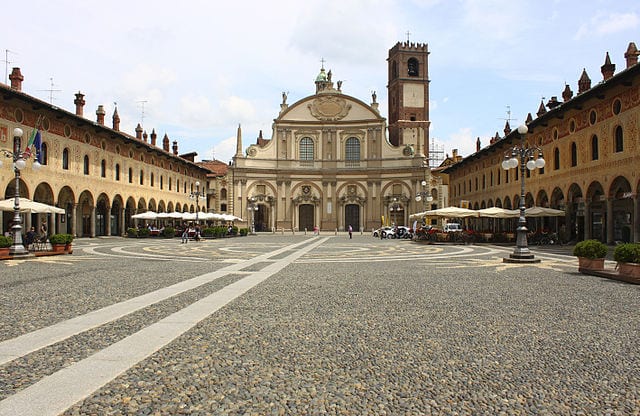
Located in Lombardy, Vigevano is an easy day-trip from Milan. | Photo from Wikicommons
The Piazza Ducale was the brainchild of Ludovico Sforza, a 15th-century Duke of Milan who had the entire thing built simply to create a more impressive entrance to his own palace. One of the preeminent rulers of the Italian Renaissance, old Ludovica also had plenty of flair. He was a patron of Bramante and Leonardo Da Vinci, and his court was never short of artists and musicians. His square was started in 1492 and took just two years to finish, looking much as it does stoday. The homogeneous buildings that surround it on three sides make the rectangular piazza seem even larger than it actually is and more like a very grand entryway than an outdoor space. The fourth side is dominated by the city’s Duomo which is home to a staggering “treasury” which is really just the private collection of relics, tapestries, and assorted treasure of Francesco II Sforza – definitely worth a look. Just 30 minutes from Milan, this beautiful Italian piazza is an excellent look at Renaissance architecture and what the dreams of a single Duke can accomplish.
Piazza Maggiore & Piazza del Nettuno, Bologna
Though Bologna’s Piazza Maggiore and Piazza del Nettuno are technically two different piazzas, they’re connected and too beautiful for us to choose between.
Piazza Maggiore is in the heart of the city and the perfect starting point to see Bologna. It’s huge, immaculately clean, and well-preserved. In the northwest corner of the piazza you can see the classic 16th-century Fountain of Neptune, marking the start of Piazza del Nettuno. At his feet are four rivers that represent the four continents that were known at the time of its creation: the Ganges, Nile, Danube and Amazon.
The surrounding piazza is small, but the striking statue makes it superbly affecting. Pay special attention to Neptune’s trident – do you recognize it? The sports car company Maserati based their logo on it.
Piazza del Popolo, Ascoli Piceno
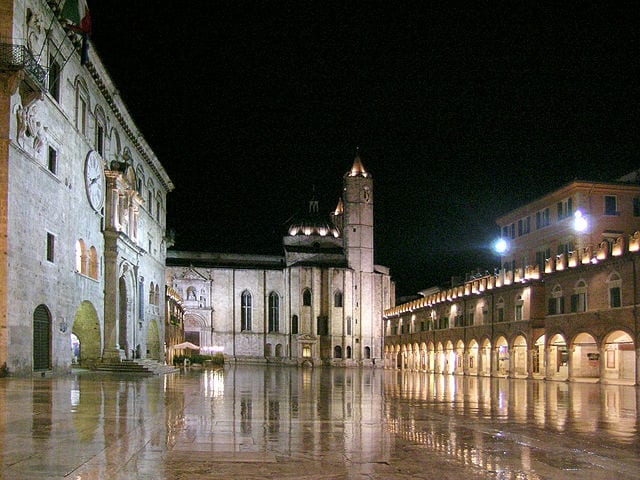
There is nothing quite like the lambent warmth of Travertine under the lights | Photo by Flavia Cenciarini, via Flickr
Ascoli Piceno is a medium-sized town in Le Marche that sits well off most tourist routes but is guarding one of the most elegant and striking piazzas in the county. It’s central square, Piazza del Popolo or Square of the People, is well known among Italians for the harmony of its Renaissance design style and the warm beauty of its travertine paving. Travertine is a type of limestone found in the surrounding mountains and used in many other famous architectural works in Italy, most famously the Colosseum. If you visit, keep an eye out for the towers that punctuate the city’s skyline. In the middle ages there were an estimated 200 of them. Now there are “only” 50.
Piazza San Pietro in Vatican City
St Peter’s Basilica needs little introduction, but many visitors are so busy getting inside that they all but ignore the feature that is both the epicenter of global catholicism and the quintessence of baroque architecture – the mighty Piazza St. Pietro. In the 17th century the great architect and artist Gian Lorenzo Bernini added the magnificent colonnade reaching from the Basilica out to embrace the approaching faithful – a design that art historian Robert Hughes has called the “greatest anthropomorphic gesture in the history of architecture.”
The colonnade includes a staggering 248 Tuscan column and 140 statues of saints. For special occasions tens of thousands of people can and do fit into the plaza to greet and be blessed by the Pope, who also holds his weekly audience here. Words like “awe-inspiring”and “monumental” were created to describe spaces like this. There is no other Italian piazza that will drop your jaw as quickly or as completely as the Piazza San Pietro.
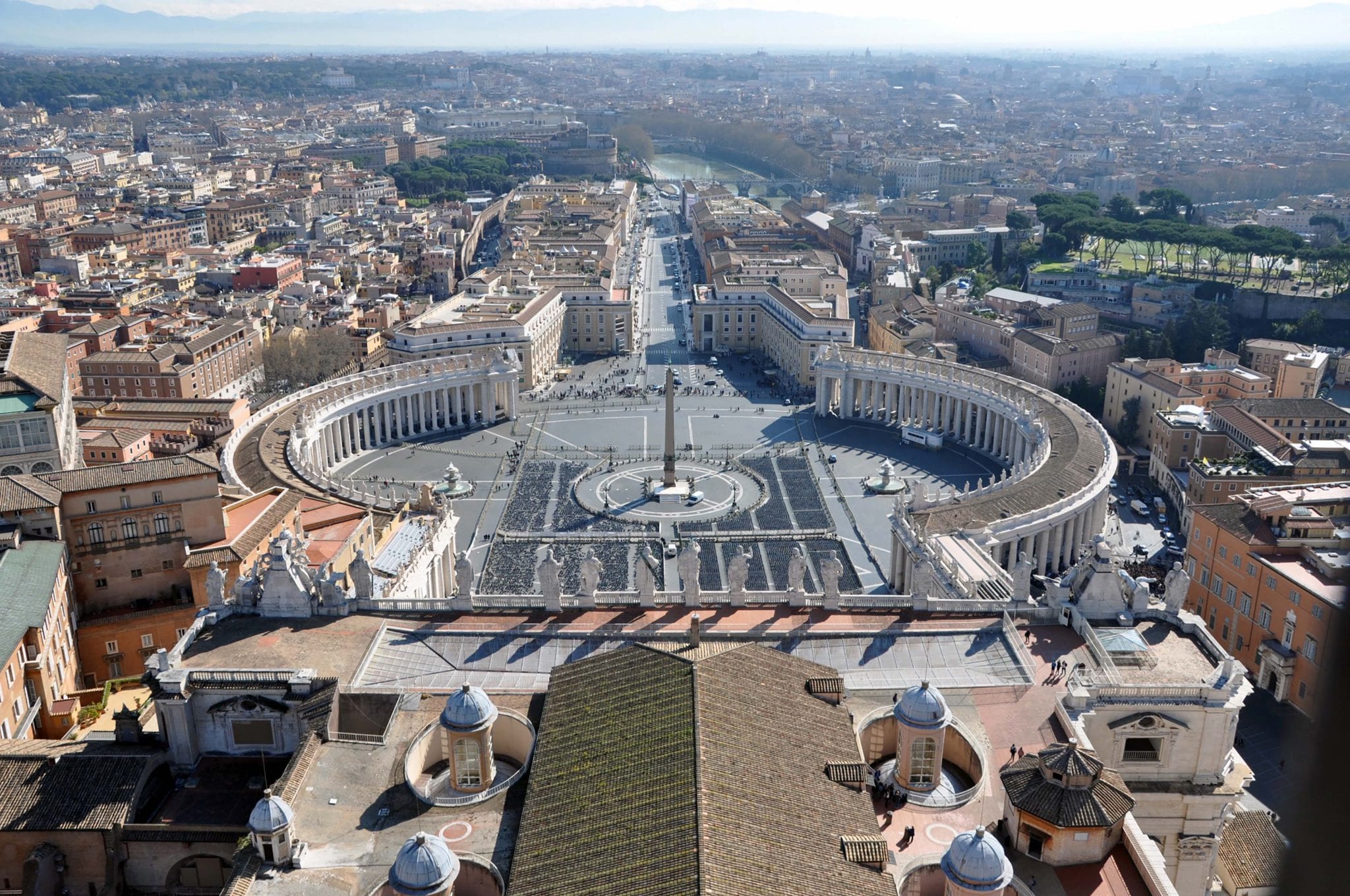
Aerial view of the Saint Peter’s square in Vatican city. Cityscape above view from the dome of the basilica
Piazza del Duomo, Lecce
Lecce is the Baroque jewel of southern Italy, and nowhere is it more charming than in its central plaza, the Piazza del Duomo. Nearly filled by the town’s beautiful Duomo and its bell tower, Piazza del Duomo overflows with fine stone work and exuberant details, like saints and mythological beasts carved into seemingly every crevice. All is cut from the local, golden limestone which gives the entire city a unique look and texture. It is one of the few “closed” Italian piazzas meaning that it has only one entrance and the distinct feeling of an intimate (if somewhat large and ornate) courtyard. Actually, it once was a courtyard with large doors that closed the entrance at night. Today one of the most pleasant experiences you can have in southern Italy is to be in the square at sundown and see the way the local limestone glows in the last rays of the dying sun.
Piazza Navona, Rome
Piazza Navona is Rome’s liveliest and perhaps best-loved square. The plaza’s ovular shape is the only reminder of its origins as a Roman chariot track but it remains a hub for both locals and visitors. Most if its defining architecture and monuments come from the 17th century when Pope Innocent X built his family palace on the piazza and commissioned the fountains that would beautify it.
This Italian piazza’s main draw, apart from the vibrant crowds that fill it during most hours of the day, is the Fountain of the Four Rivers. The Baroque masterpiece was created by none other than Bernini and was actually a comeback of sorts after he had fallen out of favor with the Pope. It is so packed with movement, whimsy, wonder, and drama that it’s often hard to know where to look.
Most impressively, though often overlooked, the Egyptian obelisk that crowns the fountain is actually suspended over thin air – a feet that should be utterly impossible given the weight of the solid-stone obelisk. Everyone thought the design would collapse as soon as it was built. Shows what they knew. Come to this piazza to enjoy street vendors, jugglers, artists, young, old, rich, poor, foreign and native all mixing on their evening passeggiata.
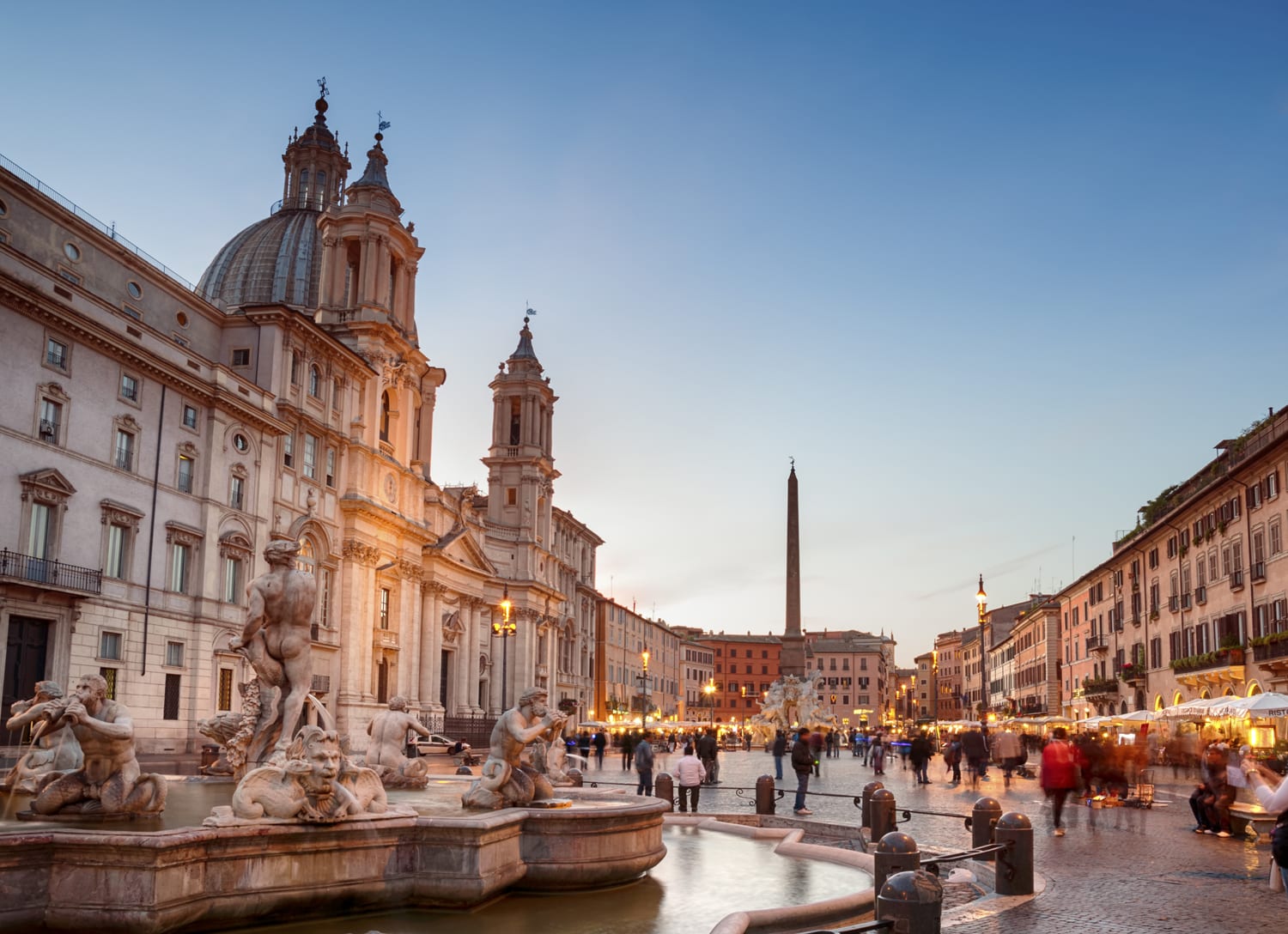
Fountain of the Four Rivers and the church of Sant’Agnese in Agone in Piazza Navona.
Piazza del Plebiscito, Naples
This Piazza’s strange name has a great background. In English its name is “plebiscite,” more commonly known as a referendum. The plebiscite in question was the vote that brought Naples under the unified Kingdom of Italy in 1860 (until then, it had been part of a separate kingdom). The beautiful Piazza is from the early years of the 19th century. It sits close to the Bay of Naples, one of Naples’ most characteristic areas and is a favorite among locals who are renowned around Italy for their boisterous street life.
Surrounded by beautiful government buildings and old monarchic residences, not to mention the gorgeous Basilica di San Francesco da Paola, it’s one of the most picturesque spots in the city. The Neapolitans know it, too. They used the plaza to host concerts, shows, open air art exhibitions, and one of the world’s great fire works shows on New Year’s Eve. There is no better place to experience the fabled street life of Naples than this exuberant, Italian piazza.
Piazza Pretoria, Palermo
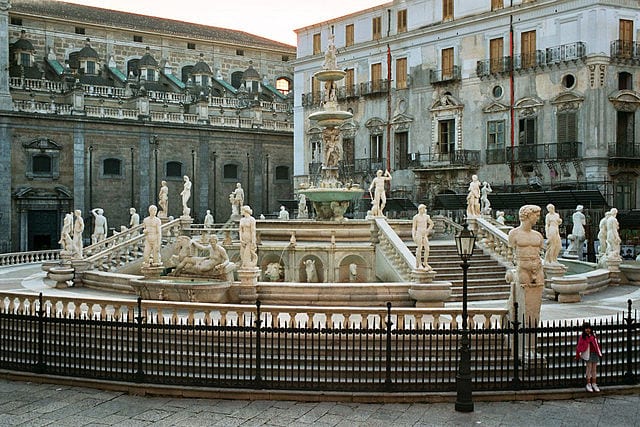
The Fontana Pretoria was originally created for a private garden in Florence. When it was unveiled in Palermo its nude statues caused quite a stir. | Photo by Bernhard J. Scheuvens
Piazza Pretoria is notable for being the site of one of the more unique public controversies in Italian civic history. located just feet from the historic city center of Palermo, it features a wide fountain called the Fontana Pretoria that is composed, like many public fountains in Italy, of a plethora of nude statues. So far, so good.
Things went awry when Palermo locals, who were firmly under the sway of the Spanish inquisition (Spain ruled Sicily at that time) when the fountain was installed in 1575, saw the nudes. In perhaps the only recorded case of Italians protesting nude statuary in history, Palermitans re-christened the plaza Piazza della Vergogna or “piazza of shame.”
Luckily, the city council, who had paid for all those shamefully naked statues, was unbowed and the fountain is now considered a local treasure. The piazza is one of the prettiest in Palermo and when the fountain is lit up at night it’s one of the prettiest in all of Italy.
by Gina Mussio
View more by Gina ›Book a Tour

Pristine Sistine - The Chapel at its Best
€89
1794 reviews

Premium Colosseum Tour with Roman Forum Palatine Hill
€56
850 reviews

Pasta-Making Class: Cook, Dine Drink Wine with a Local Chef
€64
121 reviews

Crypts, Bones Catacombs: Underground Tour of Rome
€69
401 reviews

VIP Doge's Palace Secret Passages Tour
€79
18 reviews

Legendary Venice: St. Mark's Basilica, Terrace Doge's Palace
€69
286 reviews










